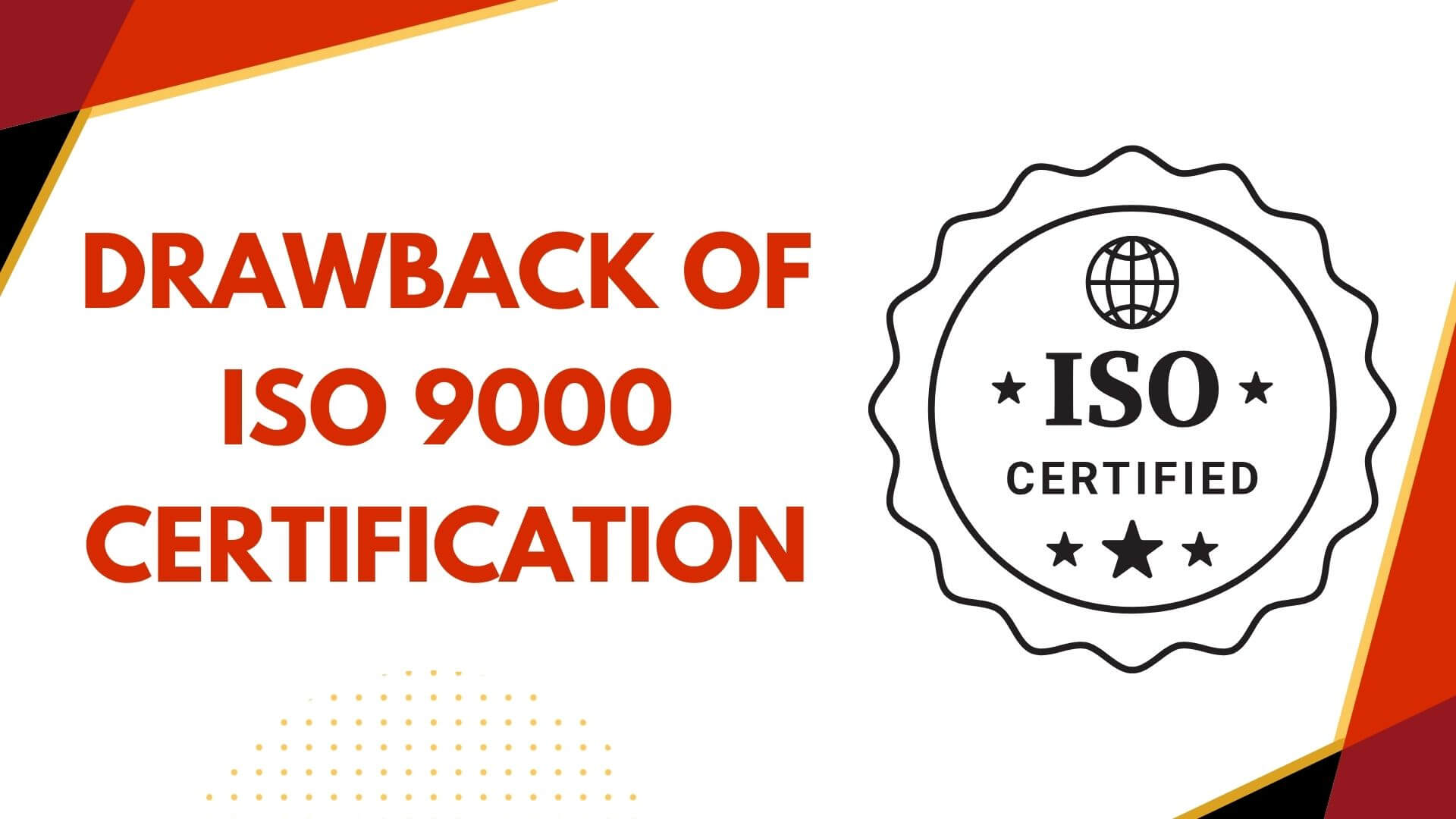Introduction:
ISO 9000 certification is a globally recognized standard
that signifies an organization's commitment to quality management and
continuous improvement. While achieving ISO 9000 certification can bring
various benefits, including enhanced customer satisfaction and increased
operational efficiency, it is essential to acknowledge that no system is
flawless. One drawback associated with ISO 9000 certification is the rigidity
it may impose on organizations, hindering their ability to adapt swiftly to
dynamic business environments.
The Drawback:
Rigidity in Processes
One of the primary goals of ISO 9000 certification is to
establish and maintain a set of well-defined processes within an organization.
While this structure is vital for quality management, it can inadvertently lead
to rigidity in operations. The standard's emphasis on documentation, adherence
to procedures, and stringent control measures might create a bureaucratic
environment, making it challenging for organizations to respond promptly to
changing circumstances.
1. Lack of
Flexibility:
One notable drawback of ISO 9000 certification is the
potential lack of flexibility it introduces into an organization's processes.
The stringent documentation requirements and standardized procedures might
limit an organization's ability to adapt swiftly to new market trends,
technological advancements, or unforeseen challenges. In rapidly evolving
industries, being agile and responsive to change is crucial for sustained
success.
2. Slow Innovation:
Innovation is the lifeblood of many successful
organizations, allowing them to stay competitive in the market. However, the
structured nature of ISO 9000 can inadvertently stifle innovation by
discouraging experimentation and deviation from established procedures.
Organizations may become hesitant to implement new ideas or adopt creative
solutions if they perceive these initiatives as conflicting with the
standardized processes required by ISO 9000.
3. Resistance to
Change:
The implementation of ISO 9000 often requires a significant
cultural shift within an organization. Employees accustomed to a more flexible
and adaptive working environment may find it challenging to adjust to the rigid
processes mandated by the certification. This resistance to change can impede
the successful integration of ISO 9000 principles and hinder the organization's
overall performance.
Mitigating the
Drawback:
While acknowledging the potential rigidity associated with
ISO 9000 certification, it is important to note that organizations can take
proactive measures to mitigate this drawback. Emphasizing a culture of
continuous improvement, encouraging employee involvement, and regularly
reviewing and updating documented processes are crucial steps to maintain
flexibility within the quality management system.
What are the limitations of
ISO 9000 certification?
ISO 9000 certification is a widely recognized standard for
quality management systems, but like any system, it has its limitations.
Understanding these limitations is crucial for organizations seeking
certification and for those evaluating the effectiveness of the ISO 9000
framework. Here are some key limitations:
1. Focus on
Documentation Over Results:
ISO 9000 places a strong emphasis on documented processes
and procedures. While documentation is essential for consistency and
traceability, the risk lies in organizations becoming overly fixated on
paperwork rather than achieving tangible results. The certification does not
guarantee product or service excellence but rather adherence to documented
processes, which may not always translate to real-world effectiveness.
2. Rigidity and Lack
of Flexibility:
The structured nature of ISO 9000 can lead to rigidity
within an organization. The focus on defined processes may hinder adaptability
and responsiveness to changes in the business environment. In rapidly evolving
industries, organizations need the flexibility to innovate and adjust quickly,
which can be constrained by the rigid requirements of ISO 9000.
3. Limited Emphasis
on Continuous Improvement:
While ISO 9000 encourages the concept of continuous
improvement, the standard may not provide sufficient guidance on how
organizations can truly embrace and implement this principle. Some
organizations may view ISO 9000 certification as a one-time achievement rather
than an ongoing commitment to improving processes and enhancing overall
performance.
4. Potential for
Bureaucracy:
The extensive documentation and procedural requirements of
ISO 9000 can lead to the creation of bureaucratic structures within
organizations. This bureaucratic burden may slow down decision-making processes
and hinder the organization's ability to be agile and responsive to market
changes or customer demands.
5. Focus on
Conformance, Not Excellence:
ISO 9000 certification primarily assesses an organization's
ability to conform to specified standards rather than its ability to excel in
delivering high-quality products or services. Some argue that a focus on
conformity might discourage organizations from going above and beyond the
minimum requirements to achieve excellence.
6. Limited
Applicability to Service Industries:
Originally designed with a manufacturing-oriented
perspective, ISO 9000 may not seamlessly fit the needs of service-oriented
industries. Service industries often have unique challenges and characteristics
that are not fully addressed by the standard, potentially limiting its
effectiveness in these sectors.
7. Costs of
Implementation and Maintenance:
Achieving and maintaining ISO 9000 certification can be
resource-intensive. The costs associated with implementing and sustaining the required
processes, documentation, and training can be significant, particularly for
small and medium-sized enterprises. This financial burden may outweigh the
perceived benefits for some organizations.
8. Customer
Satisfaction Does Not Guarantee Business Success:
ISO Certification places importance on customer satisfaction, but
meeting customer expectations alone does not guarantee business success. Other
factors such as innovation, market positioning, and effective marketing
strategies are essential for an organization's overall competitiveness and
success, which ISO 9000 does not explicitly address.
While ISO 9000 certification offers valuable guidelines for
quality management, organizations should be mindful of these limitations and
consider them in the context of their specific industry, size, and business
objectives. It is essential for organizations to view ISO 9000 as a tool for
improvement rather than a rigid set of rules, supplementing it with a
commitment to continuous learning and adaptation to remain competitive in
today's dynamic business environment.
Conclusion:
ISO 9000 certification undoubtedly provides organizations
with a valuable framework for ensuring quality and customer satisfaction.
However, it is essential to recognize that, like any system, it has its
drawbacks. The potential rigidity imposed by ISO 9000 processes can hinder
adaptability and innovation within an organization. To maximize the benefits of
ISO 9000 certification, organizations should strike a balance between adhering
to established processes and fostering a culture that encourages flexibility,
innovation, and continuous improvement.

